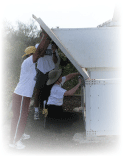Wind Profiling Radar Dismantled on San Cristóbal Island
May 10, 2007
 During the month of April, researcher Leslie Hartten of CIRES and the NOAA Earth System
Research Laboratory's Physical Sciences Laboratory met with Director Carlos
Lugo of Instituto Nacional de Meteorología e Hidrología (INAMHI) in Quito,
Equador. Dr. Hartten thanked Lugo and INAMHI for their assistance over the
past 14 years with a wind-profiling radar that NOAA operated on Isla San
Cristóbal in the Galápagos. (Photo: Dr. Leslie Hartten and helpers dismantle a wind-profiler in San Cristóbal.)
During the month of April, researcher Leslie Hartten of CIRES and the NOAA Earth System
Research Laboratory's Physical Sciences Laboratory met with Director Carlos
Lugo of Instituto Nacional de Meteorología e Hidrología (INAMHI) in Quito,
Equador. Dr. Hartten thanked Lugo and INAMHI for their assistance over the
past 14 years with a wind-profiling radar that NOAA operated on Isla San
Cristóbal in the Galápagos. (Photo: Dr. Leslie Hartten and helpers dismantle a wind-profiler in San Cristóbal.)
Dr. Hartten then spent a few days working with the observers at the INAMHI site on San Cristóbal, dismantling the profiler and associated equipment for shipment back to the U. S. She also spent time with the site meteorologist discussing INAMHI's observations. Hartten learned about historical data from the site and about ongoing observations. These include thrice daily SST measurements and daily radiosondes, as well as weekly ozonesonde launches for ESRL's Global Monitoring Laboratory.
Background:
In 1994 the former Aeronomy Laboratory's Tropical Dynamics and Climate
group deployed this 915MHz wind profiling radar at Puerto Baquerizo
Moreno on San Cristóbal Island as part of the now defunct Trans-Pacific
Profiler Network (TPPN). The TPPN was a network of wind-measuring
instruments at tropical island sites that spanned the Pacific Ocean
basin. It was developed to examine the response of the atmosphere to El
Niño ocean warming, so that insight could be gained into the changes in
U.S. weather that are strongly influenced by El Niño.
Significance:
The profiler at San Cristóbal provided high-resolution research quality
data about the movement of the air above the East Pacific Cold Tongue
for approximately 10 of the last 13 years. While the radar at San
Cristóbal was in operation, an hourly less-processed version of the wind
data was transmitted to the Global Telecommunications System (GTS) and
assimilated into forecast models at centers around the world. Research
based on this data have revealed dramatic shifts in the seasonal cycle
during the 1997-98 El Niño event as well as a decoupling in the
low-level flow during periods with SST less than 23°C. The data
collected contributes to the scientific basis for a more "global"
weather forecast, so that societal impacts of the major multi-year
weather variations can be better anticipated.
| Contact: Leslie Hartten |